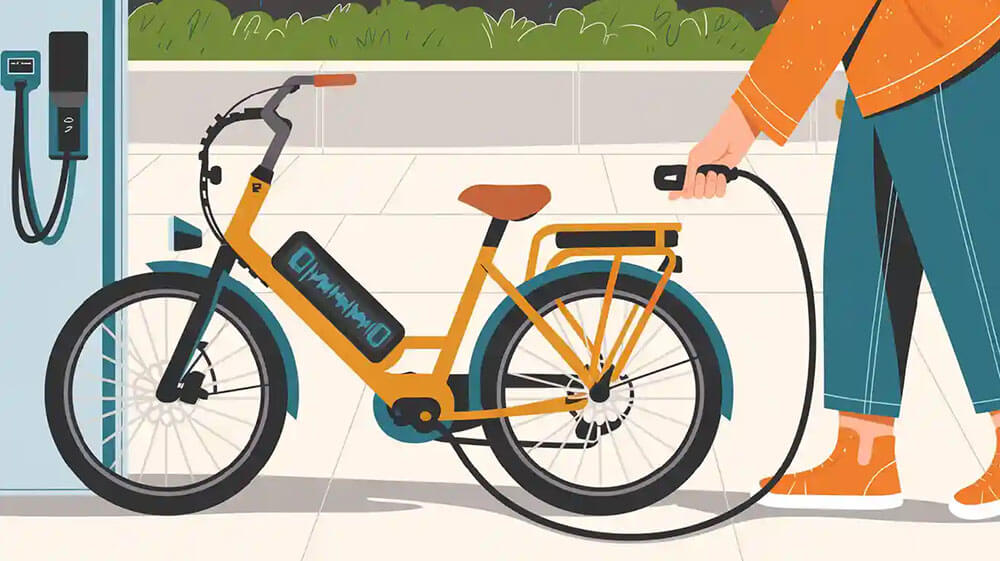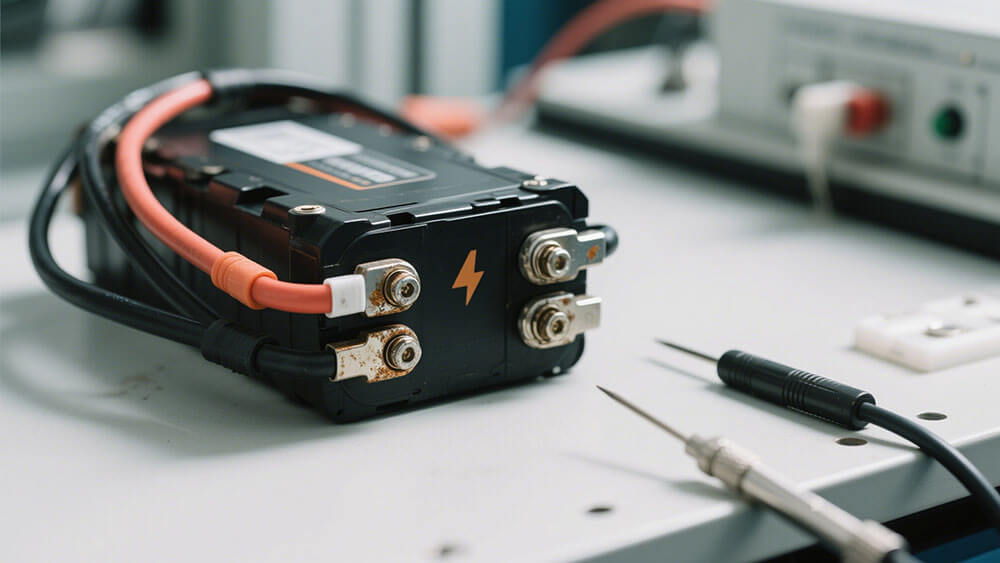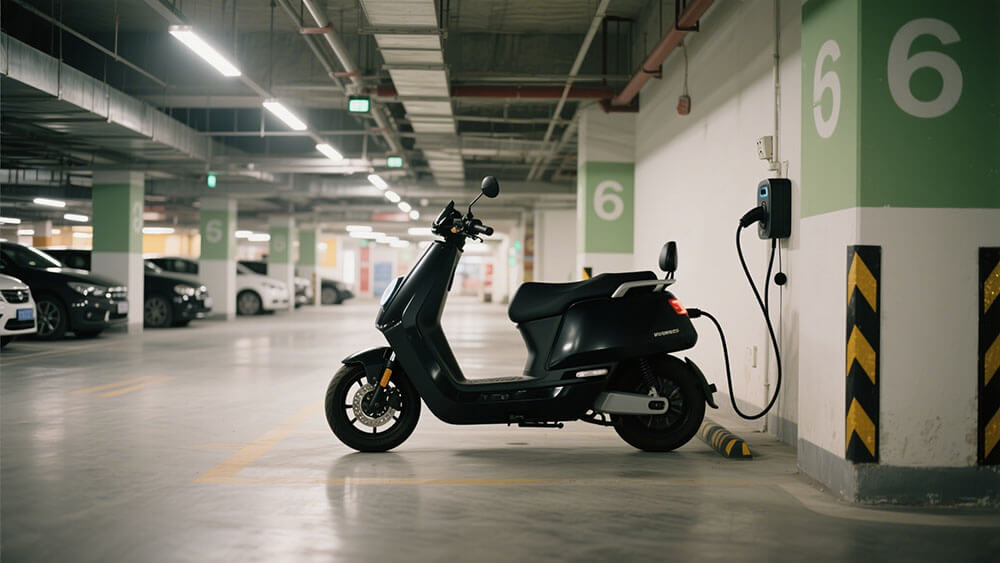
Charging your e-bike lithium battery safely is not just about convenience—it’s about preventing serious hazards. In 2023 alone, 255 fires were caused by incidents involving lithium-ion batteries, with New York City witnessing a staggering 900% increase in such fires since the pandemic. Proper charging also plays a critical role in extending battery life. By maintaining the right charging practices, such as using the correct charger and avoiding full discharges, you can maximize the efficiency of your e-bike battery while enhancing its longevity.
Key Takeaways
Charge your e-bike battery often after riding. This stops deep discharges and keeps the battery working longer.
Use the charger that came with your e-bike. A wrong charger might overheat and harm the battery forever.
Watch the battery while it charges to stay safe. Look for overheating and don’t leave it alone while charging.
Part 1: Understanding E-Bike Lithium Battery Basics

1.1 Key Features of E-Bike Lithium Batteries
E-bike lithium batteries are designed to deliver high performance and reliability. These batteries stand out due to their energy density, which determines how much energy they can store per unit volume. For example, modern lithium cells, such as 18650 models, can hold up to 3500mAh, significantly increasing the range of electric bikes compared to older models. This improvement allows you to travel longer distances without frequent charging.
Another key feature is the integration of a battery management system. This system ensures the battery operates within safe limits, preventing overheating, overcharging, or deep discharges. Additionally, advancements in fast charging technology have reduced charging time, alleviating range anxiety for riders. Safety features, such as thermal management and protective casings, further enhance the reliability of these batteries.
Feature | Description |
|---|---|
Energy Density | Continuous improvements to enhance energy density for extended e-bike range. |
Fast Charging Technology | Development of faster charging technologies to alleviate range anxiety. |
Improved Safety Features | Innovations aimed at enhancing safety to reduce risks of fire or malfunction. |
Cost Reduction | Ongoing research focused on reducing battery manufacturing costs to enhance affordability. |
1.2 Importance of Proper Charging for Battery Longevity
Proper charging practices are essential for maintaining the health of your e-bike battery. Avoiding complete discharges and using the correct charger can significantly extend the battery’s lifespan. Studies show that fast charging does not negatively impact battery longevity when done correctly. For instance, data from over 160,000 charging cycles revealed no significant difference in range degradation between frequent and occasional fast charging.
Temperature also plays a crucial role. Charging your battery in extreme heat or cold can damage its internal components. Always charge in a temperature-controlled environment to ensure optimal performance. By following these practices, you can maximize the lifespan of your electric bike battery and maintain its efficiency.
Part 2: Step-by-Step Guide to Charging Your E-Bike Battery

2.1 Preparing the Battery for Charging
Proper preparation is the first step to safely and effectively charging your e-bike battery. Start by inspecting the battery for any visible damage, such as cracks or swelling. Damaged batteries can pose safety risks and should not be charged. Ensure the battery terminals are clean and free of debris, as dirt can interfere with the charging process and reduce efficiency.
Next, place the battery in a well-ventilated area away from flammable materials. Charging in a confined or poorly ventilated space can lead to overheating. Always charge your e-bike battery in a temperature-controlled environment, ideally between 50°F and 77°F. Extreme temperatures can harm the battery’s internal components and shorten its lifespan.
Tip: Regular maintenance, such as cleaning the battery and checking for wear, can prevent issues during charging and extend the battery’s longevity.
2.2 Selecting the Right Charger for E-Bike Batteries
Choosing the correct charger is crucial for maintaining the health of your e-bike lithium battery. Always use the charger provided by the manufacturer or one specifically designed for your battery model. Using an incompatible charger can lead to overcharging, overheating, or even permanent damage to the battery.
To help you understand the differences between chargers, here’s a comparison of their performance:
Charger | Total Charging Time | Time to 80% Charge | Time for Final 20% |
|---|---|---|---|
2A | 7h 15m | 4h 40m | 2h 35m |
4A | 3h 50m | 2h 15m | 1h 35m |
5A | 3h 05m | 1h 45m | 1h 20m |
Charger | Overall Efficiency | Heat Generation | Power Consumption |
|---|---|---|---|
2A | 91.2% | Low | 102.5 Wh |
4A | 88.7% | Medium | 105.3 Wh |
5A | 85.9% | High | 108.8 Wh |
For daily charging, a 2A charger is ideal due to its low stress on the battery. A 4A charger offers a balance between speed and battery health, making it suitable for regular use. Reserve a 5A charger for occasional use when you need faster charging.
2.3 Monitoring the Charging Process for Safety
While charging your e-bike battery, monitoring the process is essential to ensure safety and efficiency. Check the charger and battery periodically for signs of overheating. If the battery becomes excessively hot, disconnect it immediately and allow it to cool before resuming.
Avoid leaving the battery unattended for extended periods during charging. Although modern e-bike batteries feature a battery management system to prevent overcharging, staying vigilant minimizes risks. Use a timer or set an alarm to remind yourself to check on the battery.
Safety Note: Never charge your e-bike battery overnight unless you are using a smart charger with an automatic shut-off feature.
2.4 Disconnecting the Battery Safely After Charging
Once the battery is fully charged, disconnect it promptly to prevent overcharging. Start by unplugging the charger from the power outlet, then disconnect the charger from the battery. This sequence reduces the risk of electrical sparks or damage to the connectors.
Store the battery in a cool, dry place if you’re not planning to use it immediately. Avoid exposing it to direct sunlight or extreme temperatures, as these conditions can degrade the battery over time. Proper storage ensures the battery remains in optimal condition for your next ride.
Reminder: Regular maintenance, such as cleaning the connectors and inspecting the battery for wear, can enhance its long-term performance.
Part 3: Common Mistakes When Charging E-Bike Batteries

3.1 Risks of Overcharging E-Bike Batteries
Overcharging e-bike batteries poses significant safety risks and can severely impact their lifespan. When a battery is overcharged, it continues to receive electrical energy even after reaching full capacity. This excess energy generates heat, which can lead to a dangerous phenomenon known as thermal runaway. In one safety study, researchers subjected batteries to an overcharge scenario with 157 volts. Within 65 minutes, the batteries experienced thermal runaway, releasing heat at a peak rate of over 1600 kW. Flames reached heights of 6–7 feet, demonstrating the severe fire hazards associated with overcharging.
Modern e-bike batteries often include a battery management system (BMS) to prevent overcharging. However, relying solely on this system without monitoring the charging process can still lead to problems. For example, using an incompatible charger or leaving the battery connected for extended periods increases the risk of overheating. To avoid these issues, always disconnect the charger promptly once the battery is fully charged. Additionally, consider using a smart charger with an automatic shut-off feature for added safety.
Safety Tip: Never leave your e-bike battery charging overnight unless you are certain the charger has built-in overcharge protection.
3.2 Charging in Improper Temperature Conditions
Charging e-bike batteries in extreme temperatures can cause irreversible damage and create safety hazards. Batteries are highly sensitive to temperature fluctuations, and improper conditions can trigger a series of dangerous reactions. For instance:
Overheating can lead to thermal runaway, where uncontrolled chemical reactions generate excess heat.
The breakdown of the electrolyte releases volatile gases, increasing the risk of explosions.
Fires caused by overheated batteries can ignite nearby flammable materials, especially in enclosed spaces.
Since 2020, the UK has reported at least 12 fatalities linked to e-bike and e-scooter fires. The number of battery-related fires has quadrupled, injuring over 190 people. A fully charged e-bike battery can release energy equivalent to six hand grenades, highlighting the potential for catastrophic incidents.
To prevent such risks, always charge your battery in a temperature-controlled environment. The ideal range is between 50°F and 77°F. Avoid charging in direct sunlight, near heaters, or in freezing conditions. If the battery feels unusually warm or cold, allow it to return to room temperature before charging.
Real-Life Example: One individual reported that their e-bike battery exploded while charging, causing significant property damage and endangering their family. This incident underscores the importance of proper charging conditions.
3.3 Ignoring Battery Maintenance Before Charging
Neglecting regular battery maintenance can lead to charging inefficiencies and shorten the lifespan of your e-bike battery. Dirt, corrosion, or loose connections on the battery terminals can interfere with the charging process, reducing efficiency and increasing the risk of overheating. Regular maintenance tasks, such as cleaning the terminals and inspecting the wiring, help prevent these issues.
Statistics show that improper maintenance can reduce battery lifespan by up to 50%. For example, failing to check water levels in flooded batteries or ignoring damaged insulation can lead to equipment failure. While e-bike batteries do not require water level checks, they still benefit from routine inspections. Before charging, always:
Clean the battery terminals to remove dirt or corrosion.
Check electrical connections for signs of wear or damage.
Inspect the battery casing for cracks or swelling.
Maintenance Tip: Schedule regular maintenance checks to ensure your battery remains in optimal condition. A well-maintained battery not only charges more efficiently but also lasts longer.
Charging Mistake | Impact on Battery Health |
|---|---|
Charging to 100% | Accelerates degradation due to full charge cycles. |
Depleting battery completely | Increases wear and tear on battery cells, leading to faster degradation. |
Frequent fast charging | Generates excess heat, contributing to battery degradation. |
High discharge rates | Common in high-performance scenarios, leading to accelerated battery wear. |
Ideal charging range (20%-80%) | Helps maintain battery health and prolong lifespan by reducing stress on the battery. |
By addressing these common mistakes, you can ensure the safety of your e-bike battery and extend its lifespan. Proper maintenance and charging practices not only protect your investment but also enhance the performance of your electric bike.
Safe charging practices are essential for maintaining the performance and longevity of your e-bike lithium battery. Regular maintenance, proper storage, and careful charging routines can significantly reduce risks and extend battery life.
Maintenance Tip | Description |
|---|---|
Regular charging | Charge the battery regularly after each use to avoid complete drainage. |
Proper storage | Store in a cool, dry place to prevent extreme temperature effects. |
Clean regularly | Keep battery and connections clean to avoid dirt and corrosion. |
To avoid common mistakes, charge only when necessary and monitor the state of charge (SOC). For example, keeping the SOC between 20% and 80% minimizes stress on the battery. Avoid charging in extreme temperatures to prevent damage.
Key Tip | Explanation |
|---|---|
Manage State of Charge (SOC) | Keeping batteries at high SOC (80-100%) increases aging; delay charging. |
Adjust Charging Routines | Charge during the day instead of overnight to avoid prolonged full charge. |
Avoid Extreme Conditions | Do not charge in freezing temperatures to prevent lithium plating. |
By following these tips, you can ensure your battery remains safe and efficient. Prioritize proper care to protect your investment and enjoy a reliable e-bike experience for years to come. 🚴♂️
FAQ
1. How often should you charge your e-bike battery?
You should charge your e-bike battery after every ride, especially if the charge drops below 50%. Avoid letting the battery drain completely to maintain its health.
Tip: Regular charging prevents deep discharges, which can shorten battery lifespan. For professional guidance on battery health, visit Large Power.
2. Can you use any charger for your e-bike battery?
No, always use the charger provided by the manufacturer or one specifically designed for your battery model. Incompatible chargers can cause overheating or permanent damage.
Note: Check your battery’s voltage and amperage requirements before purchasing a replacement charger.
3. Is it safe to charge your e-bike battery overnight?
Charging overnight is not recommended unless your charger has an automatic shut-off feature. Prolonged charging can lead to overcharging, which may damage the battery or create safety risks.




